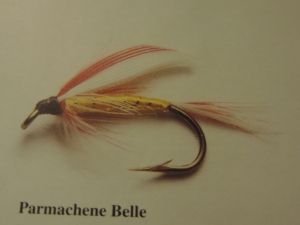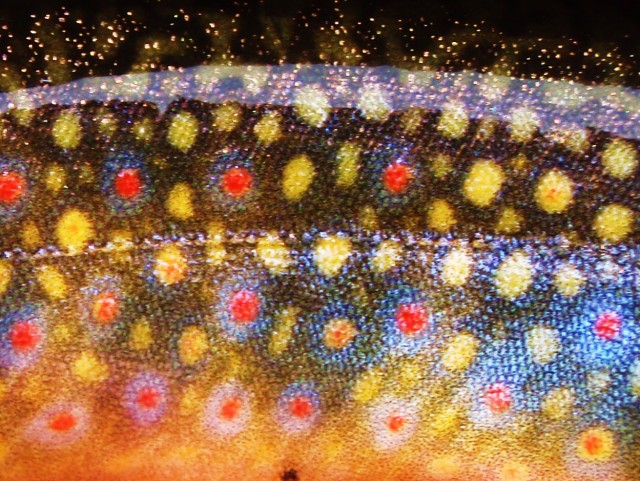Named for Parmachene Lake in the American state of Maine, the Parmachene Belle, a wet fly pattern, was first tied by Henry Wells in 1878. Ray Bergman, author of Trout,  brought fame to this pattern that had been tied, originally, for the brook trout of Maine’s big lakes and headwaters.
brought fame to this pattern that had been tied, originally, for the brook trout of Maine’s big lakes and headwaters.
In his book called Brook Trout, Nick Karas repeats the story of a legendary trout caught from the Nipigon River in the late 19th century. The subject of this narrative is a 14.5 pound brook trout that was hooked and landed with a Parmachene Belle, a wet fly that was then a local favorite.
According to Bergman (in Trout), the Belle is a popular fly that substitutes an imitation of the paired fins of the brook trout for an imitation of a natural insect. The original pattern by Henry Wells opened the field of wet fly patterns to allow development of the modern streamer fly. Bergman claims to have used it to great effect in high and slightly discolored water.
 The beautiful proportions and pleasantly contrasting colors of the Parmachene Belle have kept the pattern alive well past its 100th birthday, and they’re likely to keep it vibrant for decades to come.
The beautiful proportions and pleasantly contrasting colors of the Parmachene Belle have kept the pattern alive well past its 100th birthday, and they’re likely to keep it vibrant for decades to come.
The married quill wings are the essence of tradition that reaches back to the salmon and sea-trout roots of the British Isles, and the probable reason that I have yet to tie the Parmachene myself (wingless wets are more friendly to my average skills at the vise).
But when my sister, Barbara Lyng, agreed to build a fly for me in glass, it didn’t take me long to decide which pattern to propose. The result of her project is a beauty that will hang against a south window of my house. It brings a touch of warm tradition to these cold winter days, and a spark to fire up a springtime reverie.
How does she do it? I’ll let her own words tell the tale…
Fly in my glass (Barb Lyng)
My favorite parts of the process are picking out the proper glass, designing the project and enjoying the finished project.
When designing I have to keep in mind that you can’t just place a bird, for example, in the middle of the sky without lines going to it. Circles and curves are possible, but have more glass waste than straight lines. I try to have as little waste as possible.
When selecting the glass, each piece is held up to a bright light to see what the end effect will be. Some glass looks fantastic but is quite blah when held up to the light. And vice versa. Then all the pieces chosen have to be viewed together in the light to see how they complement each other. The actual site the finished project will hang in also affects what color is chosen.
 After drawing the project on paper, it needs to be enlarged to actual size. Then the chosen glass pieces are laid out to see if the design needs to be modified. Most glass has a direction of pattern, so that has to be taken into account.
After drawing the project on paper, it needs to be enlarged to actual size. Then the chosen glass pieces are laid out to see if the design needs to be modified. Most glass has a direction of pattern, so that has to be taken into account.
A paper pattern is then cut out for each piece of glass. The pieces are then cut, ground, washed, foiled, washed again, soldered, and then washed again. Then the frame is made, a patina is applied, the whole project is washed once more, and a chain is attached for hanging.
Thanks again, Barb. I like my Parmachene in glass. I think old Henry Wells, the first tier, would’ve gotten a kick out of it, and maybe even Ray Bergman would have smiled.


Walt- wow, that glass art is incredible. A nice way to memorialize a classic fly.
Thanks Long, for the appreciation of it!
Very nice my friend. May spring’s sunlight shine through it soon.
I’m hoping that it does, Leigh, it’s poised to do so at my southern window, waiting for that spring light that will send us back to the streams. With thanks!
The Parmachene Belle is a wonderful and productive fly. I tie a streamer version, with out the married wing.
Nice post.
I’ve seen that streamer version and am thinking to give it a try at the vise. Thanks Alan.
What a great idea and what a nice sister to bring it to life in glass.
She’s a good one, Jim, who brings her older brother a gift in glass. As always, thanks for the appreciation!
I’d like to dabble in “wets” this year. Beautiful looking glass, what a great gift and spring sunshine sounds nice right about now.
It’s back to the future when it comes to fishing with wets the way our forefathers did. Thanks for the compliment, Mike! I dabble with wets increasingly, and not just with the popular bead-head form. I think you’ll find that fishing with winged and wingless wets (the soft-hackles) is a stimulating and productive activity. It comprises the bulk of our fly-fishing history which, in itself, is also rewarding. Anyway, good luck with those flies when the warmer weather finally hits the upstate streams.